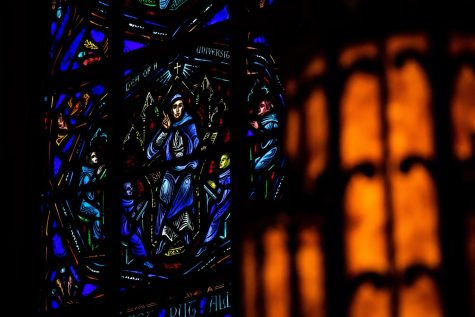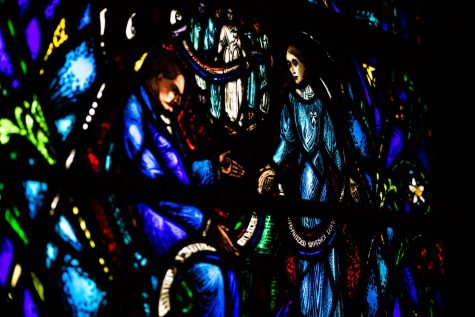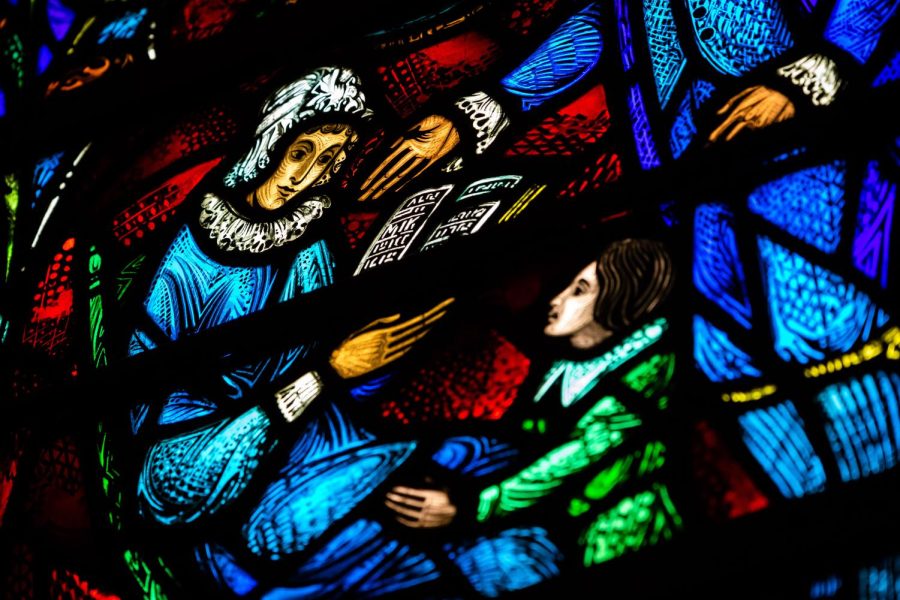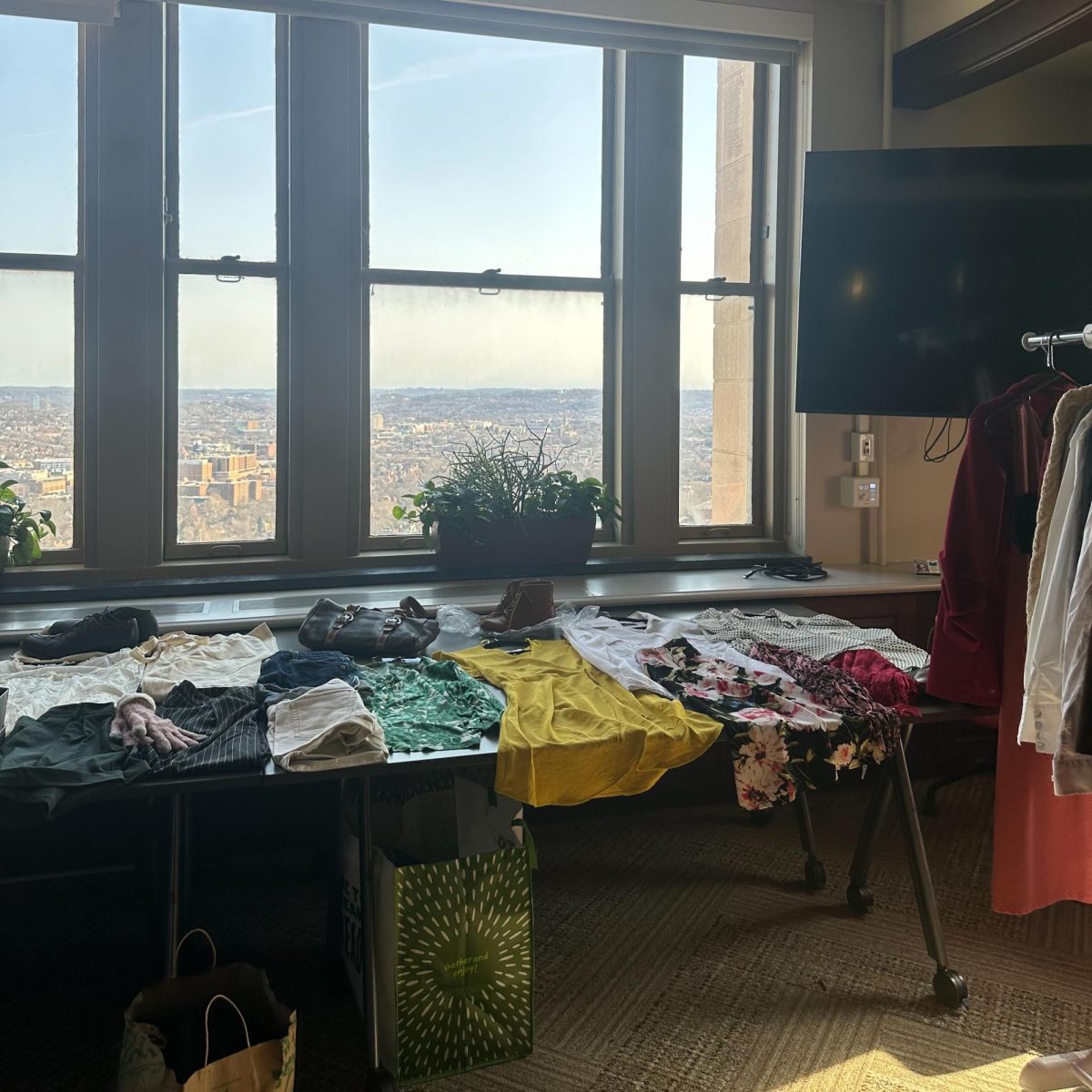Heinz Chapel celebrates Women’s History Month with ‘Women in the Windows’ tour
Ethan Shulman | Senior Staff Photographer
A stained glass window in Heinz Chapel depicting Abigail Adams, wife of U.S. president John Adams, reading a book with him and their child.
March 21, 2023
March is Women’s History Month, and one event on Pitt’s campus is encouraging visitors like Angel Mary Joseph, a junior film and media studies major, to think more about the paths women throughout history have forged.
“Knowing the foundation these women have set, and the foundation it creates for women to be represented here in such a significant location, in such prominent artwork, really inspires me,” Joseph said.
Joseph is one of many people who have visited Heinz Memorial Chapel this month for its annual “Women in the Windows” tour that runs through the end of March, which highlights different historical women who are memorialized in the chapel’s stained-glass windows. Karen Sebolt, the director of Heinz Chapel, created the program in 2018 while looking for Women’s History Month events in Pittsburgh.
“When I began working here, I thought that we should do something for Women’s History Month because we have all these women in the windows that are given equal treatment as the men, which is really special,” Sebolt said. 
Charles Connick designed the stained-glass windows, which line the entirety of the Chapel and are up to 73 feet tall and full of detailed, brightly colored panes, in the 1930s. Sebolt explained the significance of the people represented in the artwork.
“You’ll see activists, you’ll see poets and writers, people of medicine, scientists, explorers, all kinds of people,” Sebolt said. “The really remarkable thing is that the left-hand panels are all representing women. It was very unusual in the 1930s, when this building was opened, to have equal representation of women in such an environment.”
There are more than 391 people depicted in the stained glass, but Sebolt said this year she decided to focus on Emily Brontë, Sacagawea, Hilda of Whitby and Frances Willard.
“This year’s Women’s History Month theme is Women Who Tell Our Stories, and it’s in recognition of women and all forms of storytelling that capture experiences and pass them on through history,” Sebolt said. “I’ve picked Emily Brontë who was a writer and a poet, Hilda of Whitby, the patron saint of learning, Sacagawea, who wasn’t a writer but saved some very precious documents and journals from floating down a river, and Frances Willard, who wrote and gave speeches all over the world.”
The four panels featured in the tour are some of the tallest in the world, according to Sebolt. Each of the 73-foot-tall panes represents a different theme that corresponds to the people under it. The panes feature nine men on the left and nine women on the right. Emily Brontë and Hilda of Whitby are under the “truth” panel, Sacagawea is under the “tolerance” panel and Frances Willard is under the “temperance” panel. Though no one this year was highlighted from the “courage” panel, there are multiple women depicted in the windows under it.
Joseph said learning about Sacagawea, one of the few women of color depicted in the windows, was especially enjoyable.
“I liked hearing the story of Sacagawea, because I thought it was awesome to see women of color being represented in a building that was built in the 1930s,” Joseph said.
Mina Kimak, a senior environmental science major, said she enjoyed the tour because it highlights things and women that most people typically don’t know about.
“I enjoyed learning about things like Frances Willard’s involvement in the prohibition movement that you wouldn’t pick up in a classroom,” Kimak said. “Those aspects make these events so great.”
Lilly Forrest, a senior art history and film production major, was surprised to see the amount of women memorialized in the church and how many of them weren’t religiously affiliated.
“I didn’t expect there to be so many women represented,” Forrest said. “Obviously it’s mostly white women, but it’s definitely interesting. I also didn’t realize this is a nondenominational church and that there’s more science and history represented, not just religious figures.”
Like Sebolt, Kimak emphasized how much she appreciated that women were depicted just as much as men in the panels. Of the 36 historical figures included, 18 are men and 18 are women.
“I thought it was interesting to see just how many women they chose to include, and to learn about their importance and actually look at how equally represented they are in the artwor
k,” Kimak said.
Forrest said her favorite woman highlighted was Emily Brontë because she studied her in previous courses at Pitt.
“I’m a literature minor, and I took an Austen and Brontë course here,” Forrest said. “It was really fun to see her in the panels. ”
Kimak said she hopes programs like this encourage Pitt students to look into the different opportunities available on campus.
“These tours are really great resources at Pitt, and I feel like not enough students know about them,” Kimak said. “Especially since they’re free with your Pitt ID, just come and learn whatever you can.”

The “Women in the Windows” tour is running on March 26 and 27. Tickets are $10 per person or free with a Pitt ID, and reservations can be made by emailing karen.sebolt@pitt.edu.



